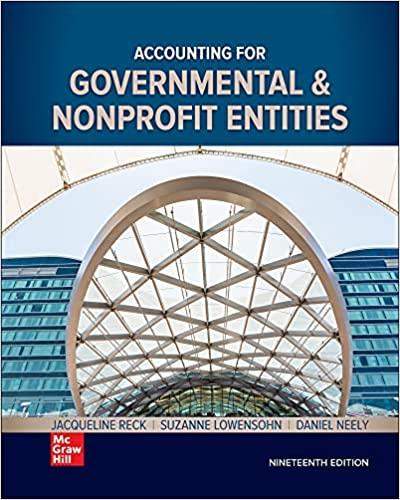Choose the best answer. 1. Which of the following statements regarding budgets of not-for-profit organizations is true?
Question:
Choose the best answer.
1. Which of the following statements regarding budgets of not-for-profit organizations is true?
a. Not-for-profit organization budgets are legal documents reflecting plans for spending resources.
b. A not-for-profit entity may choose to prepare a budget to demonstrate accountability to its resource providers, such as donors and grantors.
c. The budgeting approaches used for governments generally cannot be used by not-for-profit entities.
d. All of the given statements are true.
2. The budgeting principle in generally accepted accounting principles (GAAP) for state and local governments states that budgetary comparisons should be presented for
a. All funds of a government.
b. All major funds
c. The General Fund.
d. The General Fund and each major special revenue fund that has a legally adopted budget.
3. Which of the following steps would not usually be part of the budgeting process?
a. Heads of operating departments prepare budget requests.
b. The chief executive (mayor or city manager, as appropriate) formally adopts the budget, thus giving it the force of law.
c. One or more public budget hearings are held.
d. The budget officer and other central administrators review and make adjustments to department requests.
4. The budgetary comparisons required of state and local governments under GASB standards
a. Can be presented as a schedule within required supplementary information (RSI) or as a statement in the basic financial statements.
b. Must be a schedule included as part of RSI.
c. May be presented in the notes to the financial statements.
d. Are no longer required.
5. An approach to budgeting that requires the very existence of each program and the amount of resources requested to be allocated to that program to be justified each year is called
a. Incremental budgeting.
b. Zero-based budgeting.
c. Performance budgeting.
d. Planning-programming-budgeting.
6. Under entrepreneurial budgeting, public administrators:
a. Must justify the existence of each line-item expenditure.
b. Are encouraged to look beyond typical spending-oriented budgeting to develop the revenue side of the budget.
c. Demonstrate the inflows and outflows of all program resources.
d. Only fund programs that can pay for themselves.
7. Enterprise risk management in government
a. Was introduced during the Hoover Commissions.
b. Often relies upon preventative and control measures to achieve entity goals.
c. Facilitates goals such as cash management and long-term planning.
d. Merges strategic plans and accountability.
8. The increase in data availability has allowed governments to
a. Post large datasets online.
b. Increase the use of performance measures.
c. Facilitate fiscal transparency.
d. All of the given statements are true.
9. Which of the following does not represent a performance measurement group under the balanced scorecard?
a. Customer.
b. Internal business processes.
c. Economy and efficiency.
d. Learning and growth.
10. Governments that choose to report service efforts and accomplishments (SEA)
a. Must adhere to GASB SEA guidance.
b. Must adhere to GASB SEA guidance only if the SEA report is part of the CAFR.
c. Must adhere to guidance provided by the Association of Government Accountants (AGA) because GASB has not issued standards addressing SEA.
d. May refer to guidance provided by the GASB, the AGA, or other professional organizations.
11. Efficiency measures, as the term is used in the service efforts and accomplishments (SEA) literature, can be described as
a. Measures that relate the quantity or cost of resources used to units of output.
b. Measures that relate to the amount of financial and nonfinancial resources used in a program or process.
c. Measures that indicate costs relative to units of input.
d. Measures that reflect either the quantity or quality of a service provided.
12. Which of the following costs is generally unallowable under Office of Management and Budget (OMB) cost principles?
a. Depreciation.
b. Use allowances.
c. Employee benefits.
d. Bad debt expense.
13. Which of the following is not one of the general criteria for an allowable cost?
a. The cost must be adequately documented.
b. The cost must be approved by an external or federal auditor.
c. The cost must be accorded consistent treatment.
d. The cost must be necessary and reasonable for the performance of the federal award.
Step by Step Answer:

Accounting For Governmental And Nonprofit Entities
ISBN: 9781260118858
19th Edition
Authors: Jacqueline Reck, Suzanne Lowensohn, Daniel Neely





